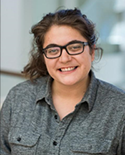People
Arash Afraz, M.D., Ph.D.
Principal Investigator

Arash Afraz received his medical doctorate from the Tehran University of Medical Sciences in 2003. Unsatisfied with clinical work and interested in research in neuroscience, he pursued his Ph.D. in Vision Science and received his degree from Harvard University in 2009 under the supervision of Dr. Patrick Cavanagh. Arash then joined the Massachusetts Institute of Technology (MIT) as a postdoctoral fellow and studied mechanisms of object recognition in Dr. James DiCarlo’s group till 2017. Arash then moved to NIH and started his lab, the unit on neurons, circuits, and behavior.
Arash claims to be interested in everything related to brain function, but he is focused on the junction of systems neuroscience and psychology. Specifically, in his research program, Arash wants to understand how elements of visual perception are shaped and constrained by the neuronal activity in high-level areas of the visual system.
Reza Azadi, M.D., Ph.D.
Postdoctoral Fellow

Reza Azadi received his Ph.D. from the State University of New York College of Optometry under the supervision of Dr. Robert McPeek. He also holds an M.D. from Jundishapur University. As a postdoc in Dr. Afraz's lab, he is investigating the link between neural activity in the inferior temporal cortex, perception, and eye movement in macaque monkeys. His research involves psychophysics as well as electrophysiology utilizing optogenetics, multielectrode-arrays, and drug micro-injections.
When he is not working, Reza enjoys outdoor activities, so if you hike, you may see him on a trail one day!
Selected Publications
Azadi, R., Bohn, S., Lopez, E., Lafer-Sousa, R., Wang, K., Eldridge, M., & Afraz, A. (2022). Behavioral detection of optogenetic stimulation in inferior temporal cortex depends on the image being viewed . https://doi.org/10.21203/rs.3.rs-1331186/v4
Azadi, R., & McPeek, R. M. (2022). Contextual saccade adaptation induced by sequential saccades . Journal of Neurophysiology, 127(3), 746–755.
Rajalingham, R., Sorenson, M., Azadi, R., Bohn, S., DiCarlo, J. J., & Afraz, A. (2021). Chronically implantable LED arrays for behavioral optogenetics in primates. Nature Methods, 18(9), 1112–1116.
Azadi, R., Zhu, E. Y., & McPeek, R. M. (2021). Modulation of saccade trajectories during sequential saccades . Journal of Neurophysiology, 125(3), 796–804.
De Vries, J. P., Azadi, R., & Harwood, M. R. (2016). The saccadic size-latency phenomenon explored: Proximal target size is a determining factor in the saccade latency. Vision Research, 129, 87–97.
Azadi, R., & Harwood, M. R. (2014). Visual cues that are effective for contextual saccade adaptation . Journal of Neurophysiology, 111(11), 2307–2319.
Elia Shahbazi, Ph.D.
Postdoctoral Fellow

Elia Shahbazi received his B.Sc. in applied mathematics from Sharif University, followed by graduate studies in pure mathematics and a couple of years in the industry. Graduated from East Carolina University with a Master's degree in software engineering and the University of Notre Dame with a Ph.D. in Computer Science and Computer Vision under Walter Scheirer's supervision. After working as a researcher for the IARPA program Machine Intelligence from Cortical Network (MICRONS) and finishing his thesis "Computer Vision-Based Approaches to Neural Circuit Tracing at Scale", Elia joined the Neuropsychology Laboratory of the National Institutes of Health in 2018. Elia's research has primarily focused on computational neuroscience and investigating causal factors in the low and high visual cortex and perception and behavior in monkeys using optogenetics and electrophysiology.
Elia is a professional photographer, podcaster, and chef!
Selected Publications
Reconstruction of genetically identified neurons imaged by serial-section electron microscopy M Joesch, D Mankus, M Yamagata, A Shahbazi, R Schalek, … elife 5, e15015
Flexible learning-free segmentation and reconstruction of neural volumes A Shahbazi, J Kinnison, R Vescovi, M Du, R Hill, M Joesch, M Takeno, … Scientific Reports 8 (1), 1-15
Private computation with genomic data for genome-wide association and linkage studies A Shahbazi, F Bayatbabolghani, M Blanton Proc. 3rd International Workshop Genome Privacy Security
A distributed key-based security framework for private clouds A Shahbazi, J Brinkley, A Karahroudy, N Tabrizi International Journal of Advanced Computer Science & Applications 4
Computer Vision-Based Approaches to Neural Circuit Tracing at Scale A Shahbazi University of Notre Dame
Evaluation of 18 F-FET-PET and perfusion MRI texture features in brain tumor grades S Assili, L Caldeira, P Lohmann, A Shahbazi, CP Filss, NJ Shah, … 2017 IEEE Nuclear Science Symposium and Medical Imaging Conference (NSS/MIC …
Perceptography: Reconstruction of perceptual perturbations induced by stimulation of the inferior temporal cortex E Shahbazi, T Ma, W Scheirer, A Afraz Vision Sciences Society
The influence of the microbiome on the 'connectome' of the enteric nervous system V Sampathkumar, M Frith, A Shahbazi, N Patel, V Leone, E Chang, … Society for Neuroscience, 2019 2019 (5), online
Treasure Island Security framework: A Generic Security Framework for public clouds A Shahbazi East Carolina University
Rosa Lafer-Sousa, Ph.D.
Postdoctoral Fellow

Rosa Lafer-Sousa received her B.A. in Neuroscience from Wellesley College in 2009, and her Ph.D. in Brain and Cognitive Sciences from MIT under the supervision of Nancy Kanwisher. Her predoctoral work aimed to shed light on the functional architecture of the primate visual system and establish links between neural activity, perception, and behavior, with a focus on color as a model system. She is now a postdoctoral research fellow at NIMH in the Laboratory of Neuropsychology working with, Arash Afraz in the Unit on Neurons, Circuits, and Behavior. She is investigating the causal role of mid and high-level visual regions in perception and behavior using optogenetics and electrophysiology in macaques.
Outside of work she enjoys doing comedy, making visual illusions, and spending time in the ocean.
Selected Publications
Behavioral detection of optogenetic stimulation in inferior temporal cortex depends on the image being viewed R Azadi, S Bohn, E Lopez, R Lafer-Sousa, K Wang, M Eldridge, A Afraz PREPRINT Research Square (2022)
Parallel, multi-stage processing of colors, faces and shapes in macaque inferior temporal cortex R Lafer-Sousa, BR Conway Nature neuroscience 16 (12), 1870-1878
Striking individual differences in color perception uncovered by ‘the dress’ photograph R Lafer-Sousa, KL Hermann, BR Conway Current Biology 25 (13), R545-R546
Color-biased regions of the ventral visual pathway lie between face-and place-selective regions in humans, as in macaques R Lafer-Sousa, BR Conway, NG Kanwisher Journal of Neuroscience 36 (5), 1682-1697
Facephenes and rainbows: Causal evidence for functional and anatomical specificity of face and color processing in the human brain G Schalk, C Kapeller, C Guger, H Ogawa, S Hiroshima, R Lafer-Sousa, ... Proceedings of the National Academy of Sciences 114 (46), 12285-12290
Color tuning in alert macaque V1 assessed with fMRI and single-unit recording shows a bias toward daylight colors R Lafer-Sousa, YO Liu, L Lafer-Sousa, MC Wiest, BR Conway JOSA A 29 (5), 657-670
Psychophysical chromatic mechanisms in macaque monkey CM Stoughton, R Lafer-Sousa, G Gagin, BR Conway Journal of Neuroscience 32 (43), 15216-15226
Binocular stereoscopy in visual areas V-2, V-3, and V-3A of the macaque monkey DH Hubel, TN Wiesel, EM Yeagle, R Lafer-Sousa, BR Conway Cerebral Cortex 25 (4), 959-971
# TheDress: categorical perception of an ambiguous color image R Lafer-Sousa, BR Conway Journal of Vision 17 (12), 25-25
Paradoxical impact of memory on color appearance of faces M Hasantash*, R Lafer-Sousa*, A Afraz, BR Conway Nature communications 10 (1), 1-10
Color-detection thresholds in rhesus macaque monkeys and humans G Gagin, KS Bohon, A Butensky, MA Gates, JY Hu, R Lafer-Sousa, ... Journal of Vision 14 (8), 12-12
Stereopsis and artistic talent: poor stereopsis among art students and established artists MS Livingstone, R Lafer-Sousa, BR Conway Psychological science 22 (3), 336-338
Vision and art: an interdisciplinary approach to neuroscience education R Lafer-Sousa, BR Conway Journal of Undergraduate Neuroscience Education 8 (1), A10
# TheDress: A Tool for Understanding How Color Vision Works R Lafer-Sousa, B Conway Journal of Vision 17 (10), 136-136
Emily Lopez, B.S.
Postbaccalaureate Fellow

Emily is a postbaccalaureate research fellow in Dr. Arash Afraz’s lab, where her work has focused on investigating the effects of IT cortical stimulation on behavior and perception. She hopes to expand upon this line of questioning by examining how IT neuronal responses interact with stimulation to influence behavior. Emily received her B.A. in Biology in 2018 from the University of Pennsylvania and joined the UNCB in the summer of 2020. She will begin her Ph.D. studies in the Program in Systems Neuroscience at Carnegie Mellon University in the fall of 2022.
Timothy Ma, B.S.
Postbaccalaureate Fellow

Timothy Ma received a B.S. in Neuroscience as well as Applied Mathematics from the University of Washington in 2019. During undergraduate studies, he worked with Wyeth Bair on optimizing the presentation of stimuli for V4 recordings. As a Postbaccalaureate Fellow in Arash’s lab, Timothy worked with Elia in finding V1 projected fields, and in Perceptography of IT. He is now pursuing a Ph.D. in Neuroscience at New York University.
Tyler Swedan, B.A.
Postbaccalaureate Fellow

Tyler Swedan received his B.A. in Psychology, and received highest honors from Emory University in 2022. He spent his first few years of undergraduate research investigating generational changes in preferences with Dr. Kenneth Carter, and later joined the Emotion Cognition and Computation lab at Emory University with Dr. Philip Kragel, working on his honors thesis investigating the influence of deliberate and automatic processing on preferential decision-making. As a Postbaccalaureate Fellow in Arash’s lab, he recently began working with Rosa studying the causal role of mid- and high-level visual regions on perception.
Outside of the lab he enjoys reading philosophy, boxing, playing guitar, and digital art.
Alumni
Karen Wang, B.A.
Karen joined the lab in 2020 as a Postbaccalaureate Fellow. She left the lab in 2022 to pursue an M.S. in Computer Science at the University of Southern California.
Simon Bohn, B.S.
Simon joined the lab in 2017 as a Postbaccalaureate Fellow. He departed in 2020 to pursue a Ph.D. in neuroscience at the University of Pennsylvania.
Archer Bowman, B.S.
Archer joined the lab in 2017 as a Postbaccalaureate Fellow. He departed in 2020 to pursue a Ph.D. in neuroscience at the Arizona State University.

